|
|
|
Sort Order |
|
|
|
Items / Page
|
|
|
|
|
|
|
| Srl | Item |
| 1 |
ID:
081124
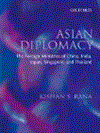

|
|
|
|
|
| Publication |
New Delhi, Oxford University Press, 2007.
|
| Description |
xiii, 246p.
|
| Standard Number |
9780195694222
|
|
|
|
|
|
|
|
|
|
|
|
Copies: C:2/I:0,R:0,Q:0
Circulation
| Accession# | Call# | Current Location | Status | Policy | Location |
| 053236 | 327.5/RAN 053236 | Main | On Shelf | General | |
| 057619 | 327.5/RAN 057619 | Main | On Shelf | General | |
|
|
|
|
| 2 |
ID:
050731


|
|
|
|
|
| Publication |
New Delhi, Manas Publication, 2002.
|
| Description |
xi, 283p.
|
| Standard Number |
8170491541
|
|
|
|
|
|
|
|
|
|
|
|
Copies: C:1/I:0,R:0,Q:0
Circulation
| Accession# | Call# | Current Location | Status | Policy | Location |
| 047701 | 327.2/RAN 047701 | Main | On Shelf | General | |
|
|
|
|
| 3 |
ID:
167817
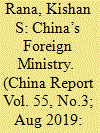

|
|
|
|
|
| Summary/Abstract |
President Xi Jinping has raised the bar in China’s engagement with the world: first, in launching in 2012 the ‘Belt and Road Initiative’ (BRI) as the idiom for intensive eco-political engagement with a wide swathe of states in Asia, Europe and Africa, plus Latin America; and second, in framing heightened global expectations for this self-avowed ‘major country’ that has moved out of the shadow of Deng Xiaoping’s 1989 hide our capacities and bide our time dictum. This places unprecedented demands on the foreign ministry, its diplomatic mission and personnel, and on all the other agencies that make up what we may call the foreign affairs network. The year 2018 has seen several new developments in the institutional structures and the work methods that connect with this enhanced priority to foreign policy implementation. This essay examines the challenges that China currently faces in pursuing its ambitious external objectives, in a fraught international environment and contestation among the world’s leading and emerging powers. Domestic challenges in coordinating actions are visible in BRI projects, which are a high national priority. The Chinese foreign ministry now receives better political support, but it remains unclear if this will suffice in meeting the major challenges they face, both abroad and at home—in working with domestic stakeholders.
|
|
|
|
|
|
|
|
|
|
|
|
|
|
|
|
| 4 |
ID:
147000
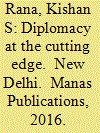

|
|
|
|
|
| Publication |
New Delhi, Manas Publications, 2016.
|
| Description |
xxv, 371p.pbk
|
| Standard Number |
9788170495116
|
|
|
|
|
|
|
|
|
|
|
|
Copies: C:1/I:0,R:0,Q:0
Circulation
| Accession# | Call# | Current Location | Status | Policy | Location |
| 058772 | 327.540092/RAN 058772 | Main | On Shelf | General | |
|
|
|
|
| 5 |
ID:
135101
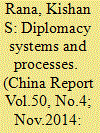

|
|
|
|
|
| Summary/Abstract |
What are the key characteristics of the diplomacy of India and China? To what extent is diplomatic capacity an issue in the management of a country’s foreign policy? For example, the number of executive level officials in the diplomatic machinery of China and India (the foreign ministries, embassies, consulates and other subsidiary offices) varies greatly in size, composition and work methods. Compared to about 1200 diplomat-rank officials in India, China has over 6500 diplomats—not counting new recruits who serve as non-diplomatic staff for their first three years, before being promoted as ‘attachés’ under their ‘3-3-4’ system. This and several other elements (structure, competence and capability) constitute a country’s ‘diplomatic capacity’; this concept has drawn new attention in the past five years. Another example is that both are large countries with a number of provinces;1 the methods used to bring them into the external policy process offers rich material for comparison, with some clear learning. China’s larger diplomatic machine does not always translate into greater effectiveness. Some Indian methods are unique and score over China’s. This essay draws on research since 1999, comparing foreign ministries (one outcome of which was Asian Diplomacy, Rana 2007).
|
|
|
|
|
|
|
|
|
|
|
|
|
|
|
|
| 6 |
ID:
050958
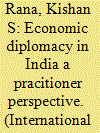

|
|
|
| 7 |
ID:
103070


|
|
|
| 8 |
ID:
153113


|
|
|
|
|
| Summary/Abstract |
Asia is in dynamic flux. From North Korea to Syria, we witness a surfeit of unresolved
problems, tensions and dilemmas; ISIS is the source of a global terrorism threat. The
South China Seas are a new locus of political tension. Yet, amidst unresolved security
threats, Asia remains on a high economic growth track, in India, China and elsewhere;
it is the world economy’s locomotive. The relationship between China and India, the
two most populous countries of Asia and the world, is tangled, complex and fraught;
it is an element in the interplay between all the major powers.
|
|
|
|
|
|
|
|
|
|
|
|
|
|
|
|
| 9 |
ID:
095950


|
|
|
|
|
| Publication |
2010.
|
| Summary/Abstract |
India's economic reforms of 1991 changed India's development paradigm, and raised the country to a new growth path. The country weathered the 2008 global recession with remarkable resilience and is now in the process of a return to an annual growth rate in excess of eight per cent. In parallel with this economic renaissance, India's external policy has also witnessed rejuvenation, described so well in C. Raja Mohan's Crossing the Rubicon1 and in other recent works.
|
|
|
|
|
|
|
|
|
|
|
|
|
|
|
|
| 10 |
ID:
050732


|
|
|
|
|
| Publication |
New Delhi, Manas Publications, 2000.
|
| Description |
477p.
|
| Standard Number |
8170491525
|
|
|
|
|
|
|
|
|
|
|
|
Copies: C:1/I:0,R:0,Q:0
Circulation
| Accession# | Call# | Current Location | Status | Policy | Location |
| 047702 | 327.2/RAN 047702 | Main | On Shelf | General | |
|
|
|
|
| 11 |
ID:
141720


|
|
|
|
|
| Summary/Abstract |
Prime Minister Modi’s May 2015 visit to China is examined with reference to several issues: the border dispute; trade, investment and economic cooperation; education, culture and people exchanges; South Asia, Pakistan; ‘Silk’, BCIM and other routes; and building trust. External Affair’s Minister Sushma Swaraj’s January 2015 hint in Beijing about an ‘out of box’ solution to the border issue was not borne out; we may ask if Indian publics are being prepared for a possible settlement, and without that it appears that the issue has not reached a tipping point where past positions become redundant. But the bilateral engagement has been widened and deepened. Modi seems to act on the premise that diplomacy can deliver result attuned to India’s basic objective of national social-economic development.
|
|
|
|
|
|
|
|
|
|
|
|
|
|
|
|
| 12 |
ID:
090285


|
|
|
|
|
| Publication |
2008.
|
| Summary/Abstract |
Regional diplomacy is today a strong force around the world. China is an early mover in this field, while India has become one, in building its active Asian connections, mainly after the launch of its economic reforms in 1991. At present, the two countries collaborate in some regional bodies where they are members or observers, and this cooperation is likely to become stronger in the future, supported by objective circumstances and economic opportunities, and the growth in their bilateral economic exchanges. This will have beneficial consequences for Asia as a whole and also, for the world community.
|
|
|
|
|
|
|
|
|
|
|
|
|
|
|
|
| 13 |
ID:
080643


|
|
|
|
|
|
|
|